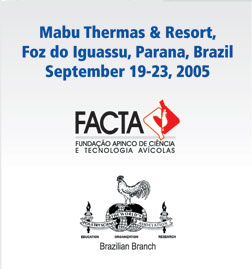Contributed Papers: Oral Presentations
Mixed Cocciodiosis Control: Drugs and Vaccines |
Rotational Programs
Combining Drugs and Coccidiosis Vaccine Improve Performance
and Profitability in a Commercial Broiler Farm
Tim CherryA, Marco A. QuirozB,
and Joey BrayA
AStephen F. Austin State University, Nacogdoches Texas,
USA
BNovus International, Inc., 20 Research Park Dr.,
St. Charles, MO 63304, USA
tcherry@sfasu.edu
It is documented
that production performance will improve after the
use of coccidiosis vaccines due to the replacement
of drug resistant oocysts with a more drug sensitive
oocyst population. A study consisting of seven grow-outs
was conducted on the SFASU Broiler Research Farm to
determine the effect of ADVENT® Coccidiosis Control,
a live oocyst coccidiosis vaccine, on performance,
and to determine if there was an improvement in performance
when going back on a coccidiostat program with a more
drug sensitive population of coccidial oocyst.
ADVENT contains sporulated viable oocysts from the
three commercially relevant species in broilers, E.
acervulina (strain VND-A10), E. maxima (strain VND-M27),
and E. tenella (strain VND-T49). Extensive screening
for anticoccidial drugs resistance confirmed sensitivity
of the strains to ionophores and chemical drugs.
Five consecutive broiler flocks were grown on a commercial
broiler farm. The study consisted of comparing performance
parameters on a four house solid-wall modern broiler
farm. Houses 1 & 2 were deemed Farm 1 and houses
3 & 4 were deemed Farm 2 for comparison purposes.
Farm 1 used a typical chemical/ionophore and 3-nitro
coccidiostat program and farm 2 used a coccidiosis
vaccine program. Both Farms employed the use of BMD-60.
Averaging the adjusted feed conversion on five consecutive
flocks, farm 1 had a 0.03 adjusted feed conversion
advantage over farm 2.
For the sixth flock, both farm 1 and farm 2 were placed
on the same anti-coccidial program. Farm 2 had a 0.11
advantage for adjusted feed conversion.
On the seventh flock, both farm 1 and farm 2 were
placed on the same anti-coccidial program. Farm 2
had a 0.07 advantage for adjusted feed conversion.
Coccidial lesion scoring (Johnson and Reid Method)
was done on five birds from each house on days 14,
21, 28, 35, and 42 through out all the grow-outs.
The improvement in Adjusted Feed Conversion on Farm
2 for the 6th and 7th flock can be directly related
to the decrease seen in coccidial lesion scores as
compared to farm 1.
The improvement in performance in the subsequent two
flocks after the five consecutive grow-outs using
ADVENT coccidiosis vaccine in the same houses may
be the result of shifting the oocyst population to
a drug sensitive population from the vaccine.
®ADVENT
is a trademark of Viridus Animal Health, LLC, and
is registered in the United States and other countries
